| Srl | Item |
| 1 |
ID:
173171
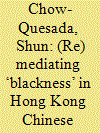

|
|
|
|
|
| Summary/Abstract |
This paper studies the representations of Africans and African cultures in Hong Kong media and the political, social, and cultural significance in shaping the socioeconomic wellbeing of Africans in the city. With the rising population of Africans in Hong Kong and the evolving nature of Africa-China relations, Africa and its cultures have become more prominent across Hong Kong’s media. Representations of the African continent in Chinese medium newspapers in the city help define the local understanding of African peoples and cultures. By analysing the construction of “African-ness” in these representations, this article shows that African cultures are constantly portrayed in relation to those of Hong Kong. It is by studying the absences and presences of “African-ness” that it can be shown that Africa is often narrated as the subordinate of the local. Significantly, this hierarchical system not only predetermines but also crystalizes the local understanding of Africa.
|
|
|
|
|
|
|
|
|
|
|
|
|
|
|
|
| 2 |
ID:
128890
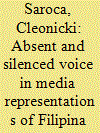

|
|
|
|
|
| Publication |
2013.
|
| Summary/Abstract |
This article explores the absent and silenced voice in Australian newspapers through case studies of two Filipino women - Nenita Westhof and Marylou Orton - who were victims of homicide in Australia. It draws on a feminist discourse analysis of newspaper articles and interviews conducted with their families and friends. The method used is one way of enabling people to hear the stories of those who do not have a voice in the present. Analysing newspaper representations in light of the interviews provides an entirely different, more accurate and just reconstruction of the women's lives. Media representations of Nenita and Marylou bore little resemblance to their 'lived reality'. In most instances, journalists did not acknowledge that the women were victims of domestic violence. Furthermore, sexist, racist and class-based discourses constructed Nenita and Marylou in accordance with dominant representations of Filipino women in Australia. They were held accountable for their own deaths, while their abusive male partners were frequently portrayed as victims of women who abused them. The article argues that such representations sensationalize the issues, misrepresent violence as the women's fault and shift responsibility from the perpetrator to the victim. In the process, they silence women's voices.
|
|
|
|
|
|
|
|
|
|
|
|
|
|
|
|
| 3 |
ID:
094169
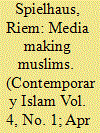

|
|
|
| 4 |
ID:
141160
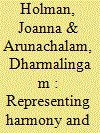

|
|
|
|
|
| Summary/Abstract |
This article investigates multiculturalism and ethnicity in Singapore. The study conducted a qualitative content analysis of articles appearing in the Straits Times newspaper over a three month period in 2010. It was found that multicultural harmony tended to be represented as unnatural, fragile, and requiring government intervention. There also tended to be a focus on distinct and fixed ethnic identities, reflecting an essentialist understanding of ethnicity. These beliefs about the nature of multiculturalism and ethnic identity were reflected in the coverage of three major social issues. These were the perceived needs to maintain the ethnic composition of Singapore’s population, efforts to prevent cultural corruption or neglect, and concerns about the impact of immigration on multicultural harmony.
|
|
|
|
|
|
|
|
|
|
|
|
|
|
|
|
| 5 |
ID:
083207
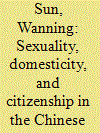

|
|
|
|
|
| Publication |
2008.
|
| Summary/Abstract |
The widespread phenomenon of outsourcing domestic work has profoundly altered the household life styles of urban families and reworked the division of labor at home. However, the extent to which urban consumers depend on the labor and service provided by the rural migrant women is by no means indicative of the degree of "harmony" and civility between the two groups. While the Chinese news media, with its urban and middle-class clientele base, see little chance of selling pictures or headlines featuring the everyday struggles of disenfranchised social groups such as rural migrant women who are employed as domestic workers, they have exercised unprecedented freedom in publishing stories about criminality and sexuality. With the figure of the maid becoming increasingly ubiquitous in urban households, urban consumers of paid domestic work also get a regular dose of "maid stories" in their everyday media consumption. Combining ethnography with detailed media analyses, this article examines the range of gendered positions and modes of sexual subjectivity which have been articulated in these stories. It shows that in a number ways the emergence of a new sexual sensibility for urban, middle-class men is contingent on the exclusion of subject positions for, and the derogation of, the "other" woman-the "intimate stranger" at home.
|
|
|
|
|
|
|
|
|
|
|
|
|
|
|
|